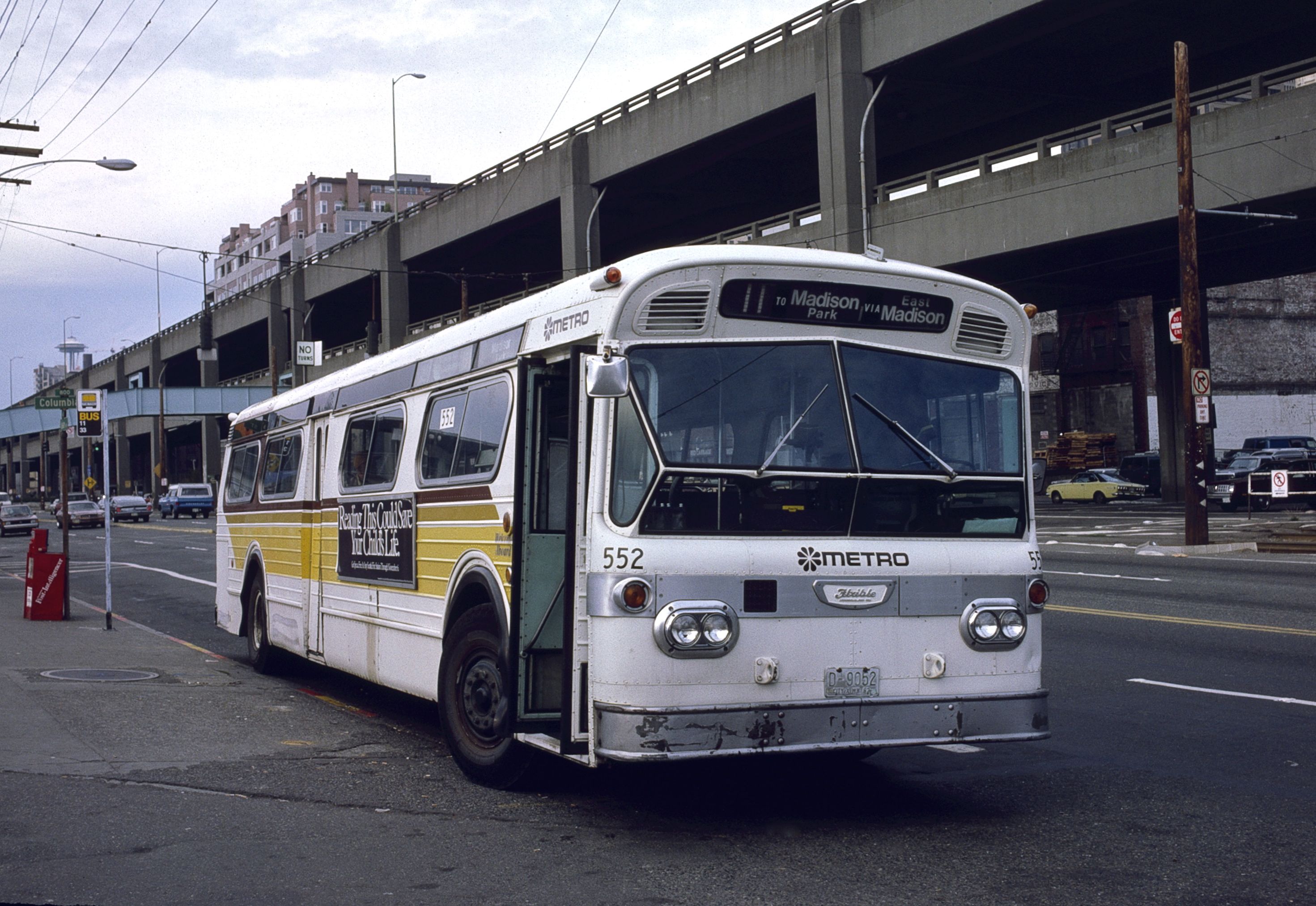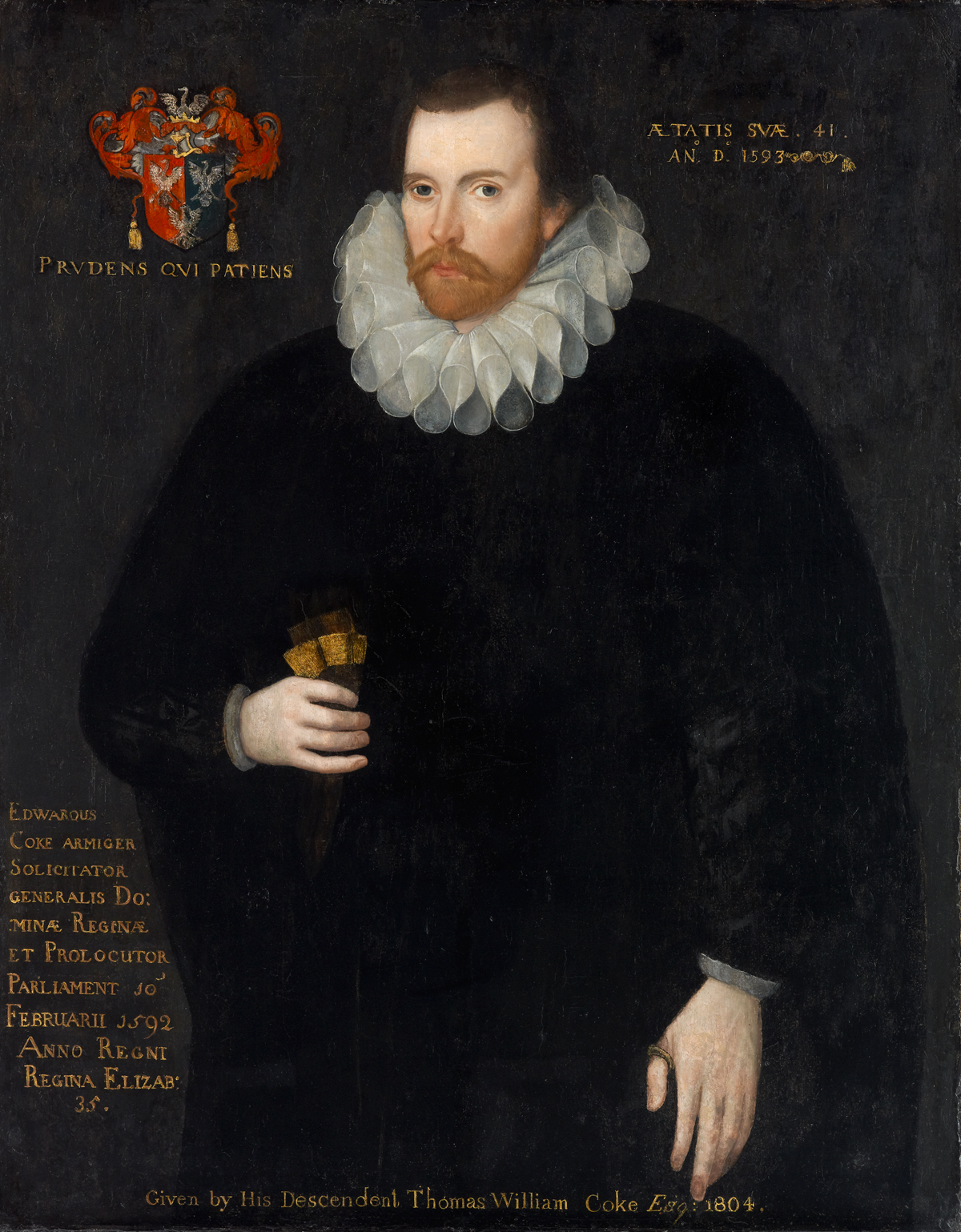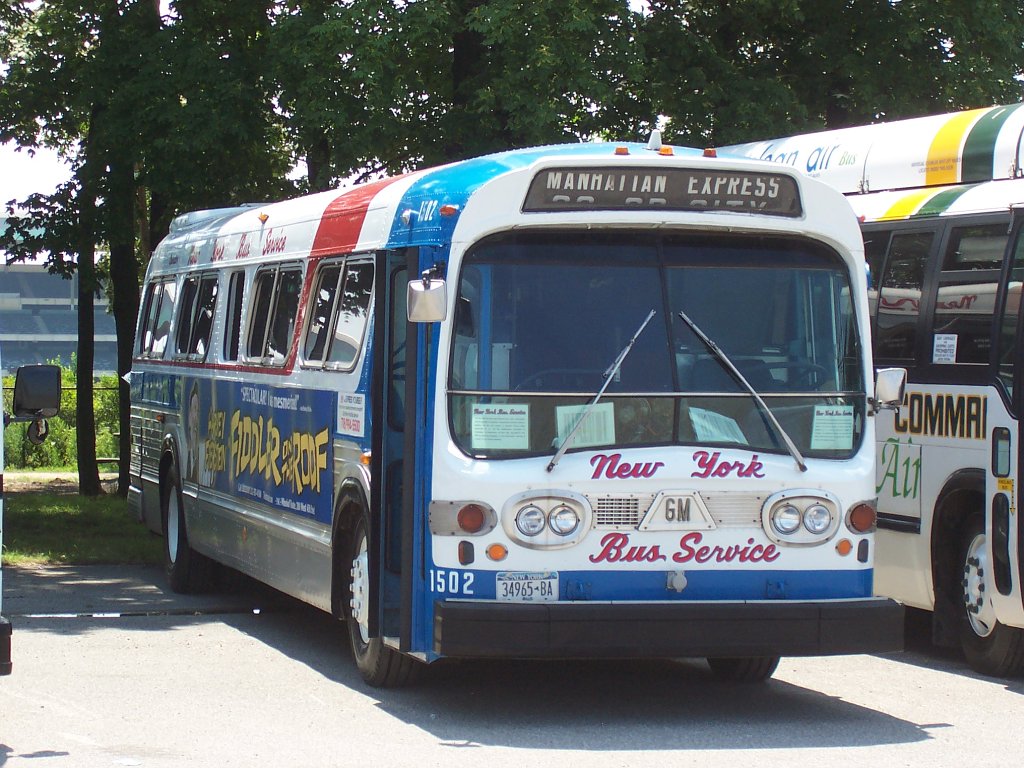|
Flxible New Look Bus
The Flxible New Look bus was a very popular transit bus introduced in 1959 by The Flxible Company, and produced from 1960 until 1978, when the New Look was replaced by the "870" Advanced Design Bus. Over its 17-year production run 13,121 Flxible New Look buses were manufactured. Design The Flxible New Look bus shares many design features with the GM New Look bus that was introduced in 1959, however the Flxible New look bus was somewhat more rugged and solid. Both buses featured large 6-piece "fishbowl" windshields, forward-slanting side windows, fluted aluminum siding, and slide/glide front passenger doors. Both buses were also equipped with the same engine: the Detroit Diesel 6V-71 (6-cylinder) / 8V-71 (8-cylinder) diesel engine (however, 150 propane-fueled Flxible New Looks were built for the Chicago Transit Authority in the mid-1960s, Detroit Diesel 4-71 (4-cylinder) diesel engines were available for some models in the mid-1960s, and Cummins 165-285 and 903 8-cylinder die ... [...More Info...] [...Related Items...] OR: [Wikipedia] [Google] [Baidu] |
Flxible
The Flxible Co. (pronounced "''flexible''") was an American manufacturer of motorcycle sidecars, funeral cars, ambulances, intercity coaches and transit buses, based in the U.S. state of Ohio. It was founded in 1913 and closed in 1996. The company's production transitioned from highway coaches and other products to transit buses over the period 1953–1970, and during the years that followed, Flxible was one of the largest transit-bus manufacturers in North America. History In 1913, Hugo H. Young and Carl F. Dudte founded the Flexible Side Car Company in Loudonville, Ohio, to manufacture motorcycle sidecars with a flexible mounting to the motorcycle. The flexible mounting allowed the sidecar to lean on corners along with the motorcycle, and was based on a design patented by Young. In 1919, the company dropped the first "E" in "flexible" and changed its name to The Flxible Company as the business looked for new opportunities to expand. After low-priced automobiles became ava ... [...More Info...] [...Related Items...] OR: [Wikipedia] [Google] [Baidu] |
Air Conditioning
Air conditioning, often abbreviated as A/C or AC, is the process of removing heat from an enclosed space to achieve a more comfortable interior environment (sometimes referred to as 'comfort cooling') and in some cases also strictly controlling the humidity of internal air. Air conditioning can be achieved using a mechanical 'air conditioner' or alternatively a variety of other methods, including passive cooling or ventilative cooling. Air conditioning is a member of a family of systems and techniques that provide heating, ventilation, and air conditioning (HVAC). Heat pumps are similar in many ways to air conditioners, but use a reversing valve to allow them to both heat and also cool an enclosed space. Air conditioners, which typically use vapor-compression refrigeration, range in size from small units used within vehicles or single rooms to massive units that can cool large buildings. Air source heat pumps, which can be used for heating as well as cooling, are becoming incre ... [...More Info...] [...Related Items...] OR: [Wikipedia] [Google] [Baidu] |
New Flyer Industries
New Flyer is a Canadian multinational bus manufacturer, specializing in the production of transit buses. New Flyer is owned by the NFI Group, a holding company for several bus manufacturers. New Flyer has several manufacturing facilities in Canada and the United States that produce the company's main product, the New Flyer Xcelsior family of buses. History New Flyer was founded by John Coval in 1930 as the Western Auto and Truck Body Works Ltd in Manitoba. The company began producing buses in 1937, selling their first full buses to Grey Goose Bus Lines in 1937, before releasing their Western Flyer bus model in 1941, prompting the company to change its name to Western Flyer Coach in 1948. In the 1960s, the company further focused on the urban transit bus market. In 1971, the then-financially struggling Western Flyer was sold to the Manitoba Development Corporation, an agency of the government of Manitoba, and renamed Flyer Industries Limited.Stauss, Ed (1988). ''The Bus World En ... [...More Info...] [...Related Items...] OR: [Wikipedia] [Google] [Baidu] |
RATP Bus Network
The RATP bus network covers the entire territory of the city of Paris and the vast majority of its near suburbs. Operated by the Régie Autonome des Transports Parisiens (RATP), this constitutes a dense bus network complementary to other public transport networks, all organized and financed by Île-de-France Mobilités. Other suburban bus lines are managed by private operators grouped in a consortium known as Optile ('), an association of 80 private bus operators holding exclusive rights on their lines. There are approximately 9500 buses serving public transportation across the Paris region, all operators included. Network RATP operates: * 70 lines with a route exclusively or mainly on the territory of the city of Paris including : ** 64 lines numbered from to ; ** the line completing (with ) a circular transport service surrounding Paris's borders along the ''Boulevards des Maréchaux'' ; ** 5 out of the 6 specially identified parisian circular bus lines designated a ... [...More Info...] [...Related Items...] OR: [Wikipedia] [Google] [Baidu] |
1971 Flxible New Look Bus - TriMet 469 (ex-628) In 1984
* The year 1971 had three partial solar eclipses (Solar eclipse of February 25, 1971, February 25, Solar eclipse of July 22, 1971, July 22 and Solar eclipse of August 20, 1971, August 20) and two total lunar eclipses (February 1971 lunar eclipse, February 10, and August 1971 lunar eclipse, August 6). The world population increased by 2.1% this year, the highest increase in history. Events January * January 2 – 66 people are killed and over 200 injured 1971 Ibrox disaster, during a crush in Glasgow, Scotland. * January 5 – The first ever One Day International cricket match is played between Australia and England at the Melbourne Cricket Ground. * January 8 – Tupamaros kidnap Geoffrey Jackson, British ambassador to Uruguay, in Montevideo, keeping him captive until September. * January 9 – Uruguayan president Jorge Pacheco Areco demands emergency powers for 90 days due to kidnappings, and receives them the next day. * January 12 – The landmark United ... [...More Info...] [...Related Items...] OR: [Wikipedia] [Google] [Baidu] |
Monopoly
A monopoly (from Greek language, Greek el, μόνος, mónos, single, alone, label=none and el, πωλεῖν, pōleîn, to sell, label=none), as described by Irving Fisher, is a market with the "absence of competition", creating a situation where a specific person or company, enterprise is the only supplier of a particular thing. This contrasts with a monopsony which relates to a single entity's control of a Market (economics), market to purchase a good or service, and with oligopoly and duopoly which consists of a few sellers dominating a market. Monopolies are thus characterized by a lack of economic Competition (economics), competition to produce the good (economics), good or Service (economics), service, a lack of viable substitute goods, and the possibility of a high monopoly price well above the seller's marginal cost that leads to a high monopoly profit. The verb ''monopolise'' or ''monopolize'' refers to the ''process'' by which a company gains the ability to raise ... [...More Info...] [...Related Items...] OR: [Wikipedia] [Google] [Baidu] |
Charles Kettering
Charles Franklin Kettering (August 29, 1876 – November 25, 1958) sometimes known as Charles Fredrick Kettering was an American inventor, engineer, businessman, and the holder of 186 patents. For the list of patents issued to Kettering, see, Leslie, Stuart W., ''Charles F. Kettering, 1876-1958'' (Doctoral dissertation, University of Delaware, 1980, available at http://udel.worldcat.org/title/charles-f-kettering-1876-1958/oclc/9128472&referer=brief_results ) (appendix VII, United States Patents Issued to Charles F. Kettering) He was a founder of Delco, and was head of research at General Motors from 1920 to 1947. Among his most widely used automotive developments were the electrical starting motor and leaded gasoline.Method and Means for Using Low Co ... [...More Info...] [...Related Items...] OR: [Wikipedia] [Google] [Baidu] |
Antitrust
Competition law is the field of law that promotes or seeks to maintain market competition by regulating anti-competitive conduct by companies. Competition law is implemented through public and private enforcement. It is also known as antitrust law (or just antitrust), anti-monopoly law, and trade practices law. The history of competition law reaches back to the Roman Empire. The business practices of market traders, guilds and governments have always been subject to scrutiny, and sometimes severe sanctions. Since the 20th century, competition law has become global. The two largest and most influential systems of competition regulation are United States antitrust law and European Union competition law. National and regional competition authorities across the world have formed international support and enforcement networks. Modern competition law has historically evolved on a national level to promote and maintain fair competition in markets principally within the territorial boun ... [...More Info...] [...Related Items...] OR: [Wikipedia] [Google] [Baidu] |
GM New Look (Fishbowl) Bus
The GM New Look bus is a municipal transit bus that was introduced in 1959 by the Truck and Coach Division of General Motors to replace the company's previous coach, retroactively known as the GM "old-look" transit bus. Also commonly known by the nickname "Fishbowl" (for its original six-piece rounded windshield, later replaced by a two-piece curved pane), it was produced until 1977 in the US, and until 1985 in Canada.Stauss (1988), p. 30. More than 44,000 New Look buses were built. Its high production figures and long service career made it an iconic North American transit bus. The design is listed as by Roland E. Gegoux and William P. Strong. Production overview 44,484 New Look buses were built over the production lifespan, of which 33,413 were built in the U.S. and 11,071 were built in Canada ( GM Diesel Division). Separated by general type, the production figures comprised 510 city buses (all U.S.-built); 9,355 city buses (7,804 U.S.-built, 1,551 Canadian); 31,348 ... [...More Info...] [...Related Items...] OR: [Wikipedia] [Google] [Baidu] |
Montreal Transportation Commission
Prior to 1959, Montreal, Quebec, Canada had an extensive streetcar system. The streetcar network had its beginnings with the horsecar era of the Montreal City Passenger Railway in 1861. The initial line was along Rue Notre Dame (Notre Dame St) from Rue du Havre (Harbor St) to Rue McGill (McGill St). Montreal Street Railway The City Passenger Railway became the Montreal Street Railway in 1886. The decision to use electricity instead of horses for propulsion was made in 1892. On September 21 of that same year, "''The Rocket''," Montreal's first electric streetcar made its maiden voyage. By 1894, the remaining horsecar lines had all been converted to accommodate the new electrically powered streetcars. The Montreal Street Railway was known as one of the most innovative and progressive in North America. One of its innovations was the introduction of the "Pay As You Enter" (P.A.Y.E.) system of fare collection in 1905. Prior to that time, conductors would walk through the c ... [...More Info...] [...Related Items...] OR: [Wikipedia] [Google] [Baidu] |
Saint-Laurent (borough)
Saint-Laurent () is a borough of the city of Montreal, Canada, located in the northern part of the island. Although it is no longer an independent city, it is still commonly known as Ville Saint-Laurent (''City of Saint-Laurent'') or by its initials, ''VSL''. Saint-Laurent is the largest of Montreal's boroughs by land area. Its population was 98,828 inhabitants in 2016. History The history of Saint-Laurent begins in the end of the 17th century with the settling of the lands given by Maisonneuve, first governor of Montreal, then by the Sulpicians, lords of Montreal's island, to Jean Descarie. His three sons were the first to settle on the lands of Cote Saint-Laurent in 1687. After the signing of the Great Peace of Montreal in 1701, 19 other settlers joined them and built a chapel the next year. The Parish of Saint-Laurent On September 20, 1720, Saint-Laurent was founded as the Parish of Saint-Laurent. On March 3, 1722, its territory was defined, it then had 29 scattered dwelli ... [...More Info...] [...Related Items...] OR: [Wikipedia] [Google] [Baidu] |

_in_1984.jpg)

.jpg)






.jpg)
